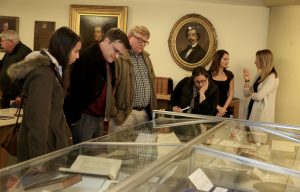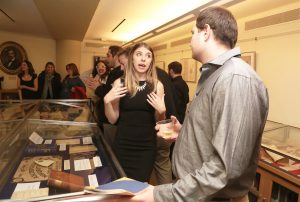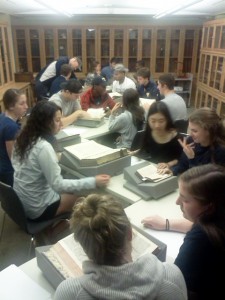 Sofia Safran ’18, the fabulous “Peer mentor” to the first-year students of my “World of Rare Books” seminar, shows off her typesetting and printing chops, displaying a poster she designed, type-set and printed herself! Sofia did a great 20-minute presentation on letterforms and typography, inspired by a summer study abroad program she took in the UK in Graphic Media & Design at the London College of Communication.
Sofia Safran ’18, the fabulous “Peer mentor” to the first-year students of my “World of Rare Books” seminar, shows off her typesetting and printing chops, displaying a poster she designed, type-set and printed herself! Sofia did a great 20-minute presentation on letterforms and typography, inspired by a summer study abroad program she took in the UK in Graphic Media & Design at the London College of Communication.
Archive for the ‘Classes’ Category
Majestic 12!
 Last night’s gala opening of Majestic 12 was a great success!
Last night’s gala opening of Majestic 12 was a great success!
More than 60 people came from as far as 100 miles away to attend the opening of our sixth annual showcase of student exhibitions, which is the product of American Studies 835, my Fall museum studies course.
The students installed a sample of their items in one case (each) in the reading room, which will remain up until June 30, 2017. Their full exhibitions are online as well, and links to all of the shows are HERE.
And here is a fuller album of photos on Flickr.
Copies of the booklet we published are available–please e-mail the Head Curator.
Many thanks to the students for all of their hard work this semester!
And we’re off!
 The Watkinson helped jump-start the first day of classes by hosting Jack Dougherty’s EDUC 300 class last night until 9:00pm. The students were asked to analyze several examples of 19th-century common school textbooks from the collection of Henry Barnard, which was bought by J. Pierpont Morgan in 1905 and made its way into Trinity’s hands when the Watkinson was given to the College in 1952.
The Watkinson helped jump-start the first day of classes by hosting Jack Dougherty’s EDUC 300 class last night until 9:00pm. The students were asked to analyze several examples of 19th-century common school textbooks from the collection of Henry Barnard, which was bought by J. Pierpont Morgan in 1905 and made its way into Trinity’s hands when the Watkinson was given to the College in 1952.
Questions put to the students as they perused various readers, geographies, primers, speakers, spellers, and even a “confederate arithmetic,” included “what do textbooks reveal about the ideology of the authors and of the common school advocates?”, “how do they portray human nature?”, “what do they reveal about religion and education?”, and “what do they reveal about everyday life inside 19th-century common schools?” (i.e., classroom organization, student-teacher interaction, and pedagogical methods).
 On Friday morning we hosted a group of high school seniors from Enfield, some from an English class but most from a philosophy course taught by Kelly Mazzone (nee O’Connor), who took an M.A. from Trinity in History in 2007 (under direction of the late Jack Chatfield).
On Friday morning we hosted a group of high school seniors from Enfield, some from an English class but most from a philosophy course taught by Kelly Mazzone (nee O’Connor), who took an M.A. from Trinity in History in 2007 (under direction of the late Jack Chatfield).
The students have been studying excerpts from Genesis, the works of St. Anselm, St. Tomas Aquinas, William Paley and Blaise Pascal, as well as passages from Milton and Dante. They seemed pretty excited and engaged when I laid out for them our editions of Paradise Lost (in ten books, 1668, and in twelve books, 1678, including a copy formerly owned by John Eliot), and several edition s of the Inferno.
Also of interest to them were our original leaf (and newly acquired facsimile of) the Gutenberg Bible, the first volumes of two of the major polyglot Bibles–Paris (1645) and London (1657)–and the 1611 first edition of the “King James Version,” not to mention two of our beautiful books of hours, and (in answer to, “what is your oldest book”?), our cuneiform tablet.
I think a few bibliophiles were born that morning–or at least, definitley quickened!
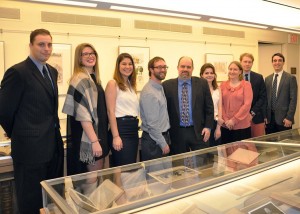 Last night we had over 50 people attend the opening of “Pieces of Eight,” the collective title of a showcase of eight separate student exhibitions in the Watkinson Library, which will run through June 30, 2016. This is the fifth annual such showcase of student exhibitions, and the turnout of faculty, students, parents and staff was very gratifying.
Last night we had over 50 people attend the opening of “Pieces of Eight,” the collective title of a showcase of eight separate student exhibitions in the Watkinson Library, which will run through June 30, 2016. This is the fifth annual such showcase of student exhibitions, and the turnout of faculty, students, parents and staff was very gratifying.
The exhibits and their curators are as follows:
Handmaid to History: What is Antiquarianism? / Elizabeth Askren ‘17
“Following the Light of the Sun, We Left the Old World”: The Dawn of Printing / Alec Buffamonte ‘17
An Uneven Playing Field: Sports and Social Classes in Britain / Marcus Cinotti, graduate student
Who You Gonna Call? Ghost Hunters from 1860-1960 / Hunter Drews ‘16
Bluejackets & Devil Dogs: U.S. Navy and Marine Corps Recruiting Posters from the Great War / Jordan Finning, graduate student
From Ragtime to Rock & Roll: Music Culture at Trinity College / Matthew Nazarian, graduate student
Victorian Ladies Leave the Sidelines: Women in Sports, 1860-1890 / Rosangelica Rodriguez, graduate student
Infant Doping and the Opium Imagination / Sarah St. Germain, graduate student
Ephemeral surprise
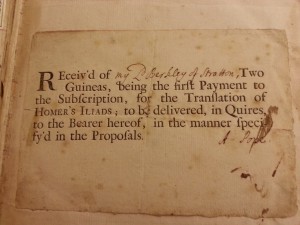 Last week in preparing a presentation for prof. Barbara Benedict’s ENGL 364 class, one of the books I pulled was our copy of the first edition of Alexander Pope’s translation of the Iliad (London, 1715-20). Pasted onto one of the flyleaves was a bit of paper that made me (and prof. Benedict, when I showed it to her an hour later) gasp in disbelief and delight. Here we have what MUST be a rare survival–a subscription ticket in Pope’s own hand, signed, for receipt of partial payment by one of his subscribers (and Pope scholars will understand the significance of this particular subscriber as well).
Last week in preparing a presentation for prof. Barbara Benedict’s ENGL 364 class, one of the books I pulled was our copy of the first edition of Alexander Pope’s translation of the Iliad (London, 1715-20). Pasted onto one of the flyleaves was a bit of paper that made me (and prof. Benedict, when I showed it to her an hour later) gasp in disbelief and delight. Here we have what MUST be a rare survival–a subscription ticket in Pope’s own hand, signed, for receipt of partial payment by one of his subscribers (and Pope scholars will understand the significance of this particular subscriber as well).
It was a great discovery of physical evidence, and allowed us to talk even more fully than we could have (using only the published subscriber’s list) about the ways in which Pope marketed, sold, and distributed the book.
 Prof. Dario Del Puppo brought his First-Year Seminar on “Food, Fitness & Self Discovery” into the Watkinson for rather non-intuitive reasons, given the title of his course, until you understand that he routinely teached Italian literature from the medieval and Renaissance periods, and then the reasons become clearer.
Prof. Dario Del Puppo brought his First-Year Seminar on “Food, Fitness & Self Discovery” into the Watkinson for rather non-intuitive reasons, given the title of his course, until you understand that he routinely teached Italian literature from the medieval and Renaissance periods, and then the reasons become clearer.
In any case, the students were immediately engaged and curious about the 11 items Dario chose to show them–from an edition of Dante’s Commedia published in 1484, a 1523 edition (almost pocket-sized) of Vitruvius’s De Architectura, and the 1632 edition of Galileo’s Dialogo.
There were lots of questions, and we looked at watermarks, bookworm damage, woodcut and copperplate illustrations, initial letters, and marbled paper–and one student even discovered a fragment of a medieval manuscript as part of the binding waste . . . . these sessions are always exciting when the students are engaged!
Back to the Future!
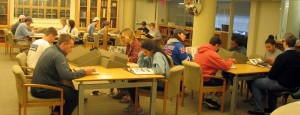 This morning we happily responded to a last-minute request to pull copies of the College yearbook (Ivy) dating from the 1950s and the 1980s for Jen Jack Gieseking’s American Studies 203 (“Conflicts & Cultures in American Society”) course. The students had recently seen the movie Back to the Future and were fascinated to look at what Trinity “looked like” in the 1950s vs. the 1980s, as professor Gieseking led them through the themes he wanted to cover–coeducation, racial equality, social norms and conflicts, etc.
This morning we happily responded to a last-minute request to pull copies of the College yearbook (Ivy) dating from the 1950s and the 1980s for Jen Jack Gieseking’s American Studies 203 (“Conflicts & Cultures in American Society”) course. The students had recently seen the movie Back to the Future and were fascinated to look at what Trinity “looked like” in the 1950s vs. the 1980s, as professor Gieseking led them through the themes he wanted to cover–coeducation, racial equality, social norms and conflicts, etc.
All of the Ivy’s are available online through our digital repository.
A teaching two-fer
This week saw a rare happening in the Watkinson: two presentations using the exact same materials for separate classes at separate institutions!
 On Monday night, profesor Scott Gac (Trinity) brough his HIST 354 class in to look at materials related to slavery in the Watkinson, which included a set of slave shackles recently donated to us, two manumission documents, and two bills of sale for slaves.
On Monday night, profesor Scott Gac (Trinity) brough his HIST 354 class in to look at materials related to slavery in the Watkinson, which included a set of slave shackles recently donated to us, two manumission documents, and two bills of sale for slaves.
 On Tuesday night, professors Bryan Sinche and Sarah Senk (University of Hartford) brought the students in a Senior Capstone Course to look at the very same items, with the addition of published slave narratives and publications of the American Colonization Society–including our very fragile issues of The Liberia Herald.
On Tuesday night, professors Bryan Sinche and Sarah Senk (University of Hartford) brought the students in a Senior Capstone Course to look at the very same items, with the addition of published slave narratives and publications of the American Colonization Society–including our very fragile issues of The Liberia Herald.
Name that body part!
 On Tuesday, a dozen first-year students participating in the Bantam Beginnings program came to the Watkinson Library to look at several rare books featuring anatomical illustrations from the 16th-19th centuries. Each student was to select a particular organ, system, etc. and compare how early anatomical illustrations compare to 21st century depictions. This was part of The Skill in Observation and Communication in Art and Medicine program, facilitated by Professor William Church.
On Tuesday, a dozen first-year students participating in the Bantam Beginnings program came to the Watkinson Library to look at several rare books featuring anatomical illustrations from the 16th-19th centuries. Each student was to select a particular organ, system, etc. and compare how early anatomical illustrations compare to 21st century depictions. This was part of The Skill in Observation and Communication in Art and Medicine program, facilitated by Professor William Church.
We had set out 9 books, all open to anatomy illustrations. The students were not only engaged with the material, but also asked many questions—both about content and the books themselves. In several cases, the students asked for dictionaries to look up terms that they didn’t understand instead of turning immediately to the internet for answers. The class was with us for about an hour with the students congregating around several of the texts, carrying on discussions about the content that ranged from questions about the images: “What is that?” “Is that a hip?” “What part of the brain is that?” “Are those lines veins coming out of the muscles?”
 They were also curious about the way the images were depicted—questioning the artistic merit/content/liberties—and asking if the images were typical of anatomy books, or of iconography found in art of the period. One of the more interesting conversations that seemed to stem from the images was how the bodies for dissection were obtained. When one of the students realized that the bodies were often of the poor, lower classes, or prisoners, she took another look at the muscles that were depicted on the skeleton and said; “Then I guess he wasn’t the most muscular specimen that they could find!”
They were also curious about the way the images were depicted—questioning the artistic merit/content/liberties—and asking if the images were typical of anatomy books, or of iconography found in art of the period. One of the more interesting conversations that seemed to stem from the images was how the bodies for dissection were obtained. When one of the students realized that the bodies were often of the poor, lower classes, or prisoners, she took another look at the muscles that were depicted on the skeleton and said; “Then I guess he wasn’t the most muscular specimen that they could find!”
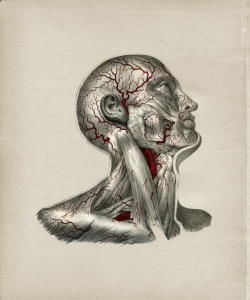 Students were particularly fascinated by illustrations in A series of anatomical plates; with references and physiological comments by Jones Quain and W.J. E. Wilson, published in 1842. This work stimulated many questions about specific organs and systems. Also of great interest was the classic work Medici De humani corporis fabrica libri septem : Cum indice rerum & uerborum memorabilium locupletissimo, by Andreas Vesalius, published in 1568.
Students were particularly fascinated by illustrations in A series of anatomical plates; with references and physiological comments by Jones Quain and W.J. E. Wilson, published in 1842. This work stimulated many questions about specific organs and systems. Also of great interest was the classic work Medici De humani corporis fabrica libri septem : Cum indice rerum & uerborum memorabilium locupletissimo, by Andreas Vesalius, published in 1568.
[Posted by Watkinson staff Henry Arneth & Peter Rawson]
